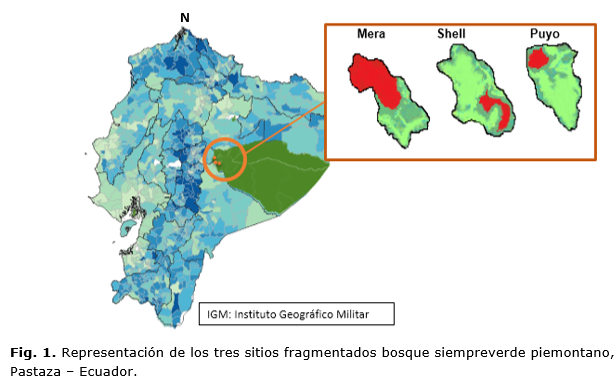Effect of the degree of anthropization in the structure, at three sites fragmented evergreen piedmont forest
Main Article Content
Abstract
The Ecuadorian Amazon is recognized worldwide for its extraordinary megadiversity and multiplicity of forest goods and services. However, the inadequate practices of extractive use of non-timber forest products, the clearing of extensive areas of forests for the development of oil activity and the unsustainable use of timber as economic sustenance of communities have led to structural and functional changes In ecosystems. The study was carried out in three sites of a degraded evergreen forest of the eastern Amazon (Mera, Shell and Puyo) in order to evaluate the effect of the degree of intervention on the forest structure. A floristic inventory was carried out with 60 plots of 25 x 25 m2 and tree species ≥ 2.5 cm d1.30 and species in natural regeneration phase with h <2 m were measured. We found 35 families, 65 genera, 101 species and 2 298 individuals, with Arecaceae, Fabaceae and Moraceae being the most representative botanical families. The degree of anthropization was highly modified where Mera was the best state of conservation. It was evidenced a low floristic diversity with patterns of alteration in the vertical and horizontal structure, distinguished phytosociologically by two strata in the sites of Shell and Puyo and by three in Mera, indicator of structural changes.
Downloads
Article Details
References
AGUIRRE MENDOZA, Z. H. Composición florística y estructura de los bosques secos y su gestión para el desarrollo de la provincia de Loja, Ecuador. Revista Cientifica Avances, 2013, 15. ISSN 1562-3297
ESCOBAR, N. Diagnóstico de la composición florística asociada a actividades agropecuarias en el cerro Quinini. Colombia: Universidad de Cundinamarca, 2013.
ESPINOSA, C.I. et al. Bosques tropicales secos de la región Pacífico Ecuatorial: diversidad, estructura, funcionamiento e implicaciones para la conservación. Ecosistemas, 2012, 21 (1-2), 167-179. ISSN: 1697-2473
GRIJALVA, J. Situación de los Recursos Genéticos Forestales – Informe País Ecuador. Preparado por el Programa Nacional de Forestería del INIAP con aval del INIAP/FAO/MAE/MAGAP/MMRREE. Documento sometido a la Comisión Forestal de la FAO-Roma, para preparación del Primer Informe sobre el Estado de los Recursos Genéticos Forestales en el Mundo, 2012.
LAMPRECHT, H. Los ecosistemas forestales en los bosques tropicales y sus especies arbóreas -posibilidades y métodos para un aprovechamiento sostenido. Alemania: Cooperación técnica. Eschborn, 1990.
LEÓN-YÁNEZ, S. R. Libro Rojo de las Plantas Endémicas del Ecuador. Quito: Universidad Católica del Ecuador, 2012.
MATOS, J. Y BALLATE, D. ABC de la Restauración Ecológica. Santa Clara: Editorial Feijóo, 2006.
MEJIA ORDÓÑEZ, T. M. Composición y estructura florística en fragmentos de bosques en los municipios de Yuscarán, Oropolí y Güinope, Departamento de el Paraíso, Honduras, C.A. Revista ciencias espaciales, 2013, 6(1), 6-22. ISSN: 2521-5868
MORENO, C. Métodos para medir la biodiversidad. Manuales y Tesis. Zaragoza, España: SEA, 2001.
PUERTO PIÑERO, C., GULLISON, R. E. Y CONDIT, S. R. Metodologías para el sistema de monitoreo de la diversidad biológica de Panamá. Panamá, 2014.


